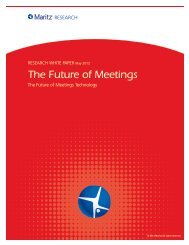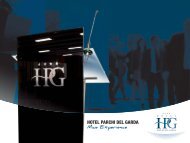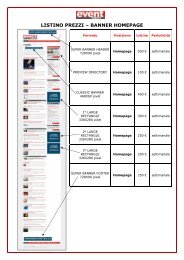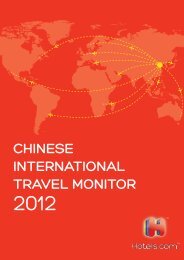The Future of Meetings - Maritz Research
The Future of Meetings - Maritz Research
The Future of Meetings - Maritz Research
- No tags were found...
Create successful ePaper yourself
Turn your PDF publications into a flip-book with our unique Google optimized e-Paper software.
RESEARCH WHITE PAPER May 2012<strong>The</strong> <strong>Future</strong> <strong>of</strong> <strong>Meetings</strong> study is published in partnership with <strong>The</strong> Hospitality Sales andMarketing Association International (HSMAI) Foundation.<strong>The</strong> <strong>Future</strong> <strong>of</strong> <strong>Meetings</strong> – OverviewIn 2002, Yahoo! Mail was five years old; iPhones hadn’t been created; and Facebook and Twitterwere non-existent. Ten years later, more people access the internet via mobile phones thancomputers; social media is a way <strong>of</strong> life; and the average consumer has more than one emailaddress. <strong>The</strong> world is changing more quickly than anyone could have possibly imagined, with thetechnology explosion as the driving force behind change.FOUNDATIONAs the meetings sector makes plans for the next two to five years, all <strong>of</strong> the stakeholders areworking hard to figure out what the future holds and how to best prepare. Having a clear picture<strong>of</strong> what to expect is a particular challenge for the sector due to the diversity <strong>of</strong> its members and theexistence <strong>of</strong> constant change in the marketplace.Those involved in planning or executing meetings come from a host <strong>of</strong> diverse industries, each withdifferent imperatives. <strong>The</strong> needs <strong>of</strong> meeting planners and designers, venue managers, speakers,exhibitors and suppliers are very different. <strong>The</strong> expanding scope <strong>of</strong> meeting types (e.g., conferences,trade shows, educational sessions, motivational gatherings, conventions and gala business events),even makes an issue <strong>of</strong> defining what constitutes a “meeting.”To address these issues, <strong>Maritz</strong> <strong>Research</strong> has undertaken an extensive project to examine the futureoutlook for the meetings sector through a combination <strong>of</strong> primary and secondary research. <strong>The</strong> goal<strong>of</strong> <strong>The</strong> <strong>Future</strong> <strong>of</strong> <strong>Meetings</strong> research series is to integrate these individual pieces <strong>of</strong> information into acohesive story. A lot <strong>of</strong> information has already been published in this area. Our purpose is to synthesizethis information and share the collective findings in four succinct white papers.Description <strong>of</strong> the <strong>Research</strong> ProcessPrimary research was conducted through an online, qualitative survey <strong>of</strong> 1,612 meetings sectorstakeholders. This study, the most comprehensive <strong>of</strong> its kind, examined four primary areas:technology, meeting design, suppliers and venues, and social media. <strong>The</strong> online study surveyed1,612 stakeholders who worked in the meetings and events sector. Forty-six percent (46%) <strong>of</strong> therespondents currently work as meeting planners, with another 43 percent currently employed assuppliers to the meetings industry. <strong>The</strong> remainder represented a diverse group including speakers,attendees, and procurement agents.Unlike most surveys, this process asked the survey participants to generate their own thoughtsand ideas about the future in response to a series <strong>of</strong> open-ended questions. <strong>The</strong> average length <strong>of</strong>the survey was more than 20 minutes, but some reported spending several hours to complete thesurvey. <strong>The</strong> fact that so many took the time to express their thoughts in such detail demonstrates thehigh amount <strong>of</strong> engagement in the topic.Additionally, numerous in-depth interviews, both formal and informal, were conducted with sectorexperts and commentators. <strong>Maritz</strong> also conducted an extensive literature review to reconcile keyfindings from other credible resources to complement the primary research.© 2012 <strong>Maritz</strong> All rights reserved 2
RESEARCH WHITE PAPER May 2012<strong>Future</strong> Challenge - Three Shades <strong>of</strong> GreenBe green, eat green and save green. <strong>The</strong> challenge for meeting venues <strong>of</strong> the future will be howto do all three.While “cost and value” and “sustainability” are both frequently mentioned topics in the <strong>Maritz</strong><strong>Future</strong> <strong>of</strong> <strong>Meetings</strong> survey research, comments concerning cost are mentioned six times forevery one mention <strong>of</strong> a sustainability topic.For venues in particular, both cost and sustainability comments typically refer to eatinggreen food. <strong>The</strong> discussion <strong>of</strong> cost for venues centers most vocally on the cost <strong>of</strong> food andbeverage services, while the discussion <strong>of</strong> “sustainability” for venues typically focuses on the<strong>of</strong>fering <strong>of</strong> locally grown food, organic food and healthier dietary options.“Green meetings are still growing in popularity”“I would like to see menus that address the increasing number <strong>of</strong> vegetarians, glutenintolerances, and health conscience (participants).”“I think venues need to follow trends in the market and stay flexible. For example, ahot trend is green meetings, green living, etc. If you can capitalize on the moment, itcan give you a boost”.<strong>The</strong> dilemma facing venues as they move forward is how to balance these conflicting ideas.“<strong>The</strong> ‘green’ factor will become more important. However …depending on incomingbusiness (they) might not have the budget and knowledge to update their facilities tothe latest standard.”“Green initiatives can be tricky based on the cost <strong>of</strong> organic and local food options aswell as the extra steps in food composting/measurement etc.”While “cost and value”and “sustainability”are both frequentlymentioned topics inthe <strong>Maritz</strong> <strong>Future</strong> <strong>of</strong><strong>Meetings</strong> survey research,comments concerningcost are mentioned sixtimes for every onemention <strong>of</strong> asustainability topic.It is a challenge that has to be met. Survey participants point to the three “greens” as being ademand upon venues that will only grow with the passage <strong>of</strong> time. How to service the greenmeetings market will be the subject <strong>of</strong> case studies and noted in the news for quite a while [V11].“We are… growing organic herbs and spices for our caterer on-site.”“Also, it takes money to upgrade venues to meet green standards. For example,challenging to find the capital for a new green ro<strong>of</strong>.”While the number <strong>of</strong> green meeting venues will grow, they will likely remain in the minority forthe near future. With spiralling costs for food and sustainability initiatives on one side, and on theother, a demand for transparent sustainability practices, specifically local food products, increasedfood options (e.g., greater variety and healthier) along with lower costs; meetings venues are in aseemingly no-win situation. One size does not fit all. While some venues will choose to specializeand cater to the green movement, others will concentrate on a more cost-driven customer base.© 2012 <strong>Maritz</strong> All rights reserved 6










